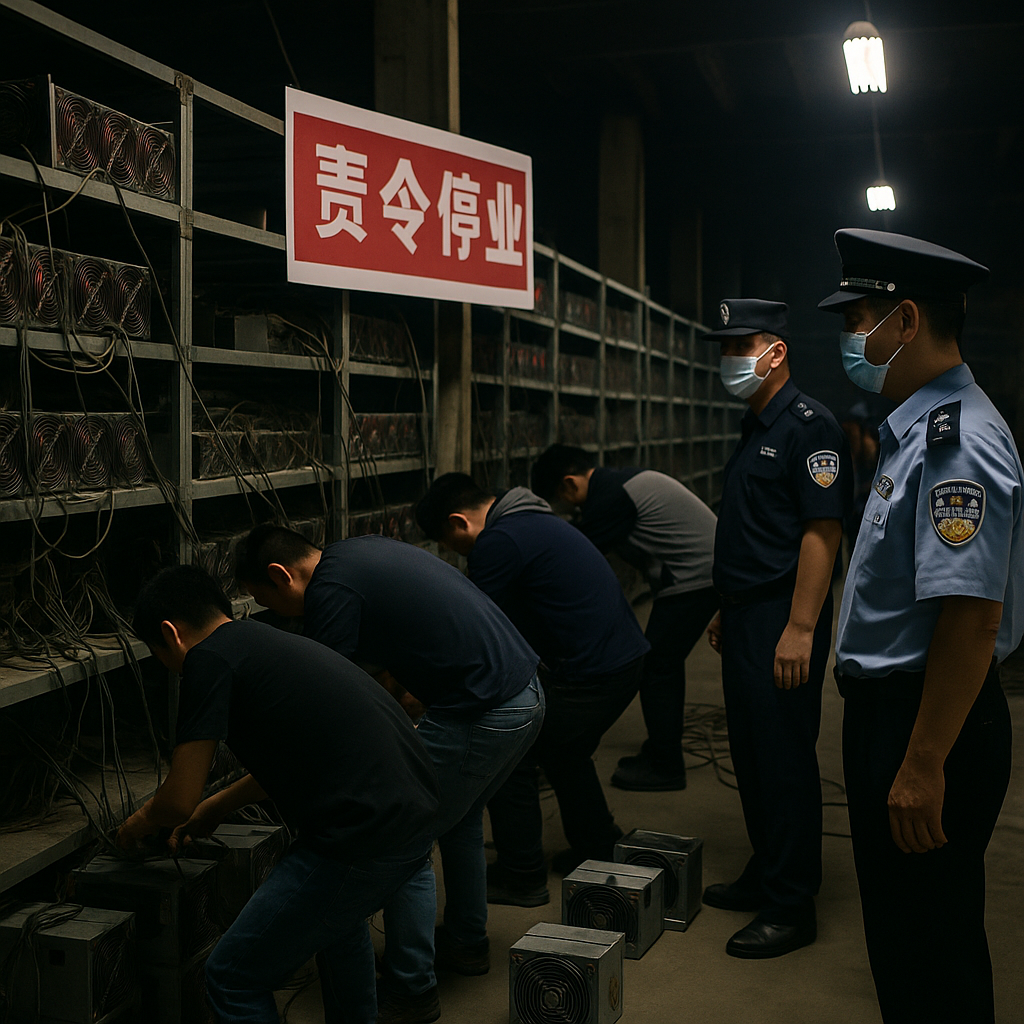China Bans Crypto Mining, Bitcoin and Markets Plunge
May 14, 2021 — China has once again shaken the global cryptocurrency markets. In a sweeping crackdown, Chinese authorities have announced a nationwide ban on crypto mining, targeting both individual miners and industrial-scale operations across several provinces. The impact was immediate: Bitcoin tumbled below $40,000, dragging altcoins down with it and wiping out hundreds of billions in market capitalization overnight.
This latest action adds to a long list of crypto restrictions by Chinese regulators, but this time the message is unequivocal: mining is no longer welcome in China — once the global epicenter of Bitcoin hash power.
What Exactly Did China Ban?
The announcement came from China’s State Council Financial Stability and Development Committee, which listed Bitcoin mining as an activity that must be “cracked down upon” due to concerns over financial risks, energy consumption, and capital outflows.
Provinces like Inner Mongolia, Xinjiang, Sichuan, and Yunnan, which were major mining hubs due to cheap electricity, have been ordered to shut down operations. Inspections began almost immediately, and several mining farms have gone offline.
The policy not only restricts mining but reinforces bans on crypto trading and speculative behavior. Banks and payment platforms have been warned against servicing crypto-related businesses.
Immediate Market Fallout
The market reaction was swift and brutal.
-
Bitcoin plunged to around $36,000, down nearly 30% from earlier in the month.
-
Ethereum, which had just crossed the $4,000 mark, saw a sharp correction to near $2,300.
-
Altcoins across the board — from Binance Coin to Cardano — saw double-digit losses.
-
Mining stocks and crypto-linked ETFs also dipped globally.
Investors, already skittish from Elon Musk’s recent reversal on Bitcoin payments for Tesla, were caught in a storm of panic selling.
Why Does This Matter?
China has long been the world’s largest Bitcoin mining hub, contributing over 65% of the global hash rate just months ago. Its abundance of cheap electricity — especially from hydropower in western provinces — made it the ideal location for industrial-scale mining.
This crackdown signals a major geographic shift in the Bitcoin network. With China out of the picture, miners must relocate operations, facing logistical, regulatory, and cost challenges.
Additionally, the move underscores China’s dual objectives:
-
Reduce systemic financial risk associated with volatile crypto markets.
-
Prepare the ground for its own central bank digital currency (CBDC) — the digital yuan — by eliminating competition.
Impact on the Bitcoin Network
The hash rate — the computational power securing the Bitcoin network — dropped sharply following the ban, as Chinese miners began shutting down rigs. Some analysts estimate a 30-50% decline in hash power over a few weeks.
While this doesn’t make Bitcoin less secure, it slows block times temporarily and may impact miner profitability.
The silver lining? The Bitcoin network is designed to self-correct. Every two weeks, the mining difficulty adjusts based on total hash rate. This will gradually restore normal block production levels.
Where Are Miners Headed Now?
Displaced Chinese miners are now scrambling to find new homes. Potential destinations include:
-
United States: Texas is leading the charge with cheap energy, crypto-friendly policies, and a growing ecosystem.
-
Kazakhstan: Already home to a number of mining farms, with loose regulations.
-
Russia: Energy-rich regions and political alignment with decentralization.
-
Canada: Particularly Quebec and Alberta, which offer surplus hydroelectric and natural gas resources.
-
Northern Europe: Iceland and Norway offer renewable energy but limited scalability.
This reshuffling may take months but will likely lead to a more decentralized and geographically diverse mining network, which many see as a net positive in the long term.
Environmental Debates Reignited
China’s crypto mining ban also came on the heels of growing environmental concerns about Bitcoin’s energy usage — a topic that gained global traction after Elon Musk cited it as a reason for Tesla suspending BTC payments.
The crackdown in coal-reliant regions like Inner Mongolia feeds into the narrative that crypto needs to go green.
This could be a turning point for:
-
Transitioning to renewable-powered mining in other countries.
-
Encouraging transparency in mining operations’ energy sources.
-
Driving innovation in proof-of-stake (PoS) and other low-energy consensus models — like Ethereum 2.0.
How Are Investors Reacting?
The sell-off, while dramatic, has not led to full capitulation. Many long-term holders are viewing this as a buying opportunity, with “diamond hands” memes resurfacing on Reddit and Twitter.
Still, institutional investors are watching cautiously. Regulatory unpredictability — especially from a country as powerful as China — adds systemic risk to their crypto exposure.
But some are finding comfort in Bitcoin’s ability to remain resilient. Despite the bans, it continues to operate, validate blocks, and facilitate trustless transactions.
What Does This Mean for the Future of Crypto?
Short-term volatility is almost guaranteed, but the long-term outlook remains debated.
Bullish perspectives argue that:
-
This marks the end of centralized mining dominance.
-
The market will rebound as hash power migrates and stabilizes.
-
Mining will become more sustainable and globally distributed.
-
Regulatory clarity in other countries could attract investment.
Bearish perspectives highlight:
-
Continued regulatory hostility from other governments.
-
Weak hands and retail fear.
-
Loss of Chinese retail participation in crypto due to stricter enforcement.
One thing is certain: the crypto space is undergoing a major stress test, and only the most resilient projects and investors will thrive.
Conclusion
China’s mining ban is a watershed moment in crypto’s evolution. It’s painful in the short term but may prove healthy in the long run — forcing the industry to mature, decentralize, and confront its environmental impact.
Markets may be down today, but crypto has weathered worse storms. And as Bitcoin finds new homes outside China, the foundation for a more resilient and decentralized future may be quietly taking shape.
